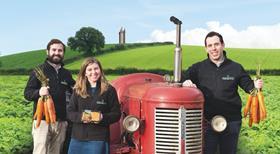
The dramatically titled “supermarket wars” between Britain’s biggest retailers has intensified the search for brand identity, but finding it in a concentrated market isn’t easy. Especially when discounters Aldi and Lidl have put huge pressure on the established retailers to converge on price. With supermarkets fighting for market share, the urge to stand out has become more of a riddle for marketing folk.
Dominic Weaver, managing director of Red Communications, says the tug of war will push retailers into finding novel ways of differentiating themselves to shoppers.
“The UK supermarkets are in a remarkable period of change. The discount sector has really shaken things up in the last four to five years, winning a lot of market share with its budget proposition. This has caused problems for some retailers – particularly those such has Asda, whose unique selling points are also in the discount area,” Weaver says.
“Some are pulling out the stops to show they can match the discounters – rationalising ranges and dropping prices further. I think we’re going to see some interesting developments in the near future as supermarkets attempt to re-differentiate themselves in new ways.”
Yet despite the downward pressure on prices, retailers and suppliers are taking a more holistic approach to their marketing, with price taking a back seat to the produce itself, in what could be described as an emerging “authenticity war”.
“People are still price sensitive, but there are lots of other things which form a part of their decision,” says Michael Jarvis, head of marketing at potato supplier Albert Bartlett. “People are looking for something they know where it comes from, and where it’s grown. We can track our produce to an individual field. People are looking for an authentic product, and honesty is a key expectation.”
Authenticity and its flipside, traceability, have become the key drivers of marketing strategies across the supply chain in recent years. As Mash Direct’s head of marketing Jack Hamilton puts it, “it’s the spirit of the times”.
“Our differentiation is trying to bring consumers closer to farming. Everything we’re trying to do with our marketing is about tying it to the farm. People are increasingly sat at their desks and are more detached from their food. Food might be the closest thing we get to the natural world in a day.”
Albert Bartlett adopts a similar ethos, employing a personal touch in its marketing strategies. “The vast majority of our products have the name of the farmer who grew it on the front of every bag so you can tell where it’s come from. I think the main trend is this conveyance of authenticity. People are interested in where their food comes from. We show how we work with farmers, working with them in the fields right the way through.”
If the expression of authenticity from suppliers and retailers is the new norm, it’s natural to ask if it’s as much a reaction to recent setbacks in the supermarket’s image due to debacles like the horsemeat scandal and the lesser fake farm controversy.
“I think it’s more a celebration of local produce rather than a reaction to negative stories, I don’t think that tells the real story,” says Hamilton. “There may be a damage in trust for some people but British culture is about celebrating the local.”
Weaver adds: “I think the retailers are extremely tuned in to what their customers are thinking. Whatever you think about Tesco’s farm brands, what they are doing is no different from what other supermarkets do. Media stories about such issues can give the impression that huge numbers of customers are unhappy with these products, whereas the vast majority are either unaware of them, they just want to put food on their tables, or they are comfortable with this approach.”
Something that has facilitated the celebration of authenticity is social media, which allows suppliers to communicate their work directly to consumers. Hamilton says it has “levelled the playing field” for growers, who previously wouldn’t have been able to afford the advertising space of their competitors.
“When it comes to the big grocery stores with crazy marketing budgets, we can’t compete with them, but with something like traceability we can walk out into the field and tweet a picture of it. We also use a drone to take pictures of the field and put it up online.”
In this sense, fresh produce marketing could increasingly resemble a diary rather than a promotion, with suppliers becoming the authors of their own campaigns. “When we have a great story to tell you don’t want someone else holding the pen,” says Hamilton. As a popular quote by marketing guru Ann Handley affirms: “Good content isn’t about good storytelling. It’s about telling a true story well.”
The incentive to tell a story, rather than promote a product means the medium of storytelling could be the new battleground for engaging consumers. “I think anything that can get across the message of traceability and provenance is going to be what wins,” concludes Hamilton.
Weaver adds: “There is certainly a trend towards shoppers wanting more authenticity in their food, and this will be increasingly important in the future. Technology should be able to facilitate this – consumers could be brought face to face with the farmer who grew their food using a VR headset, for example.”
It may sound far-fetched, but virtual reality is already being used to provide engaging demonstrations of provenance. McDonald’s is using virtual reality headsets in roadshows after teaming up with Harper Adams University, where users can explore the farms that produced their ingredients.
Hamilton sounds a cautious note though: ”Virtual reality is interesting, although I’m not sure if people will want to sit on a VR tractor for hours. I think something like smell, for example, could be more of an emerging area, if there’s some way there to get that across. Trying to work with the senses in any way – that could be really interesting.”



